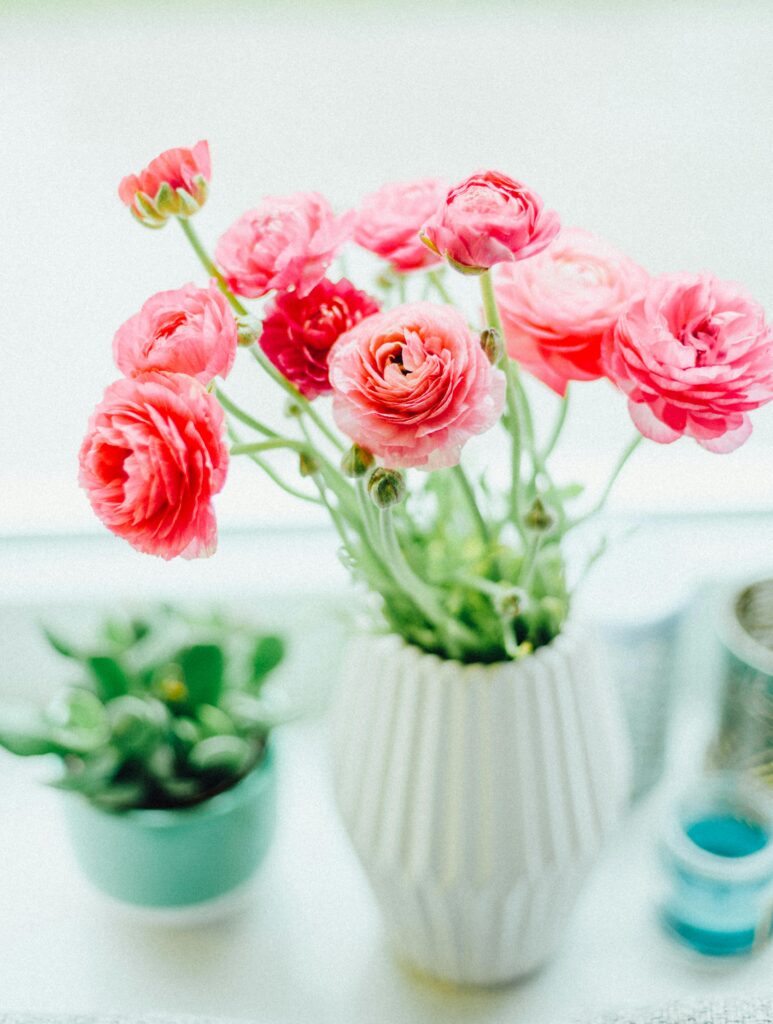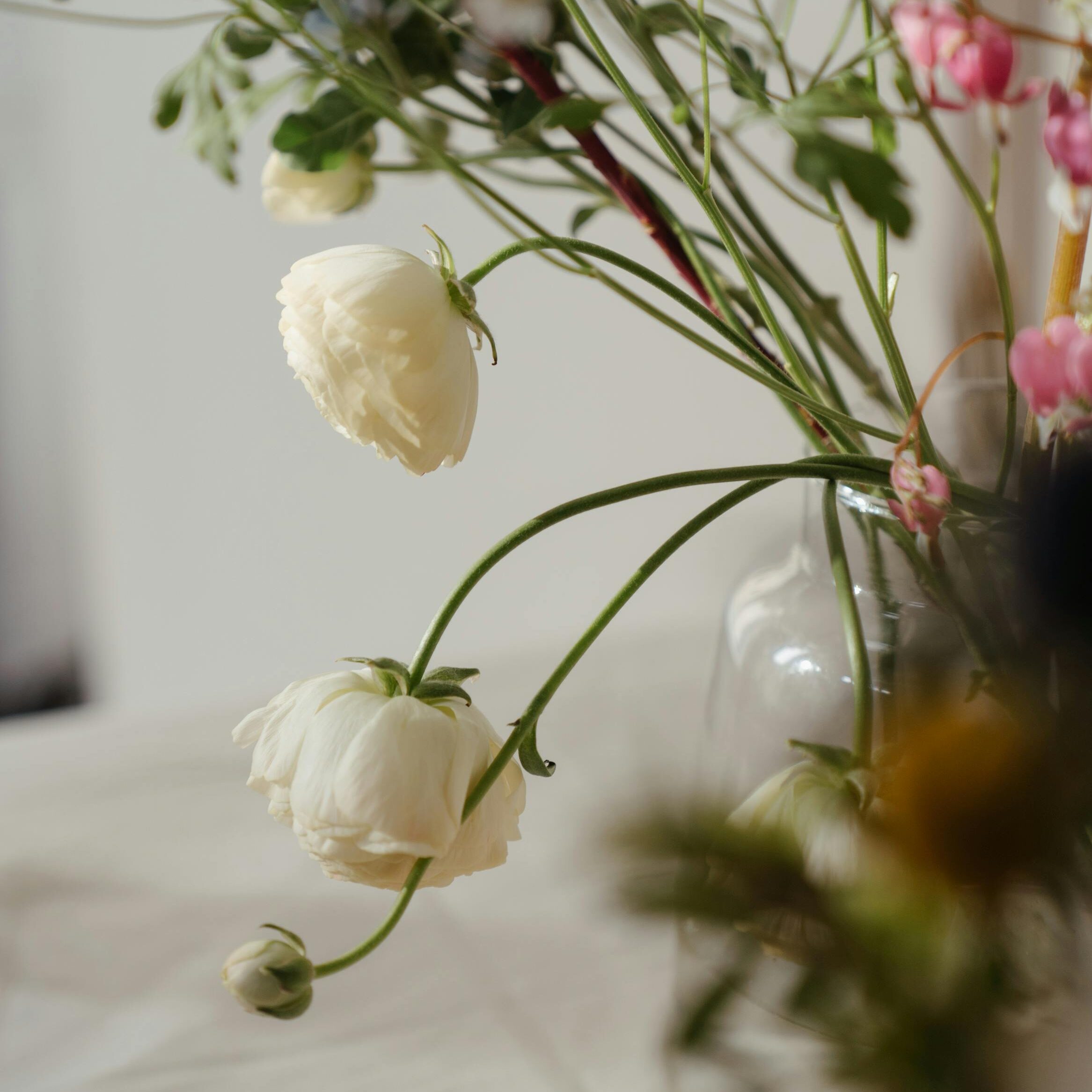The ranunculus flower is popular among plant enthusiasts and home gardeners. The flowers are vibrant and have multi-layer petals. They have prolonged blooming and beautiful displays of colors. It blooms in the late winter but also in early summer. This pleasant flower elevates home space and gardens as well.
The ranunculus flower belongs to the family of ranunculaceae, they are commonly known as buttercup. These species require bright sunlight and thrive in moist soil. It prefers a warm environment and 6 hours of sunlight daily.
Ranunculus planting process:
Pot selection:
Choosing a pot with a good drainage system is the way to go. I prefer the terracotta pot with a hole at the bottom end. The ranunculus wants moist soil but not soggy. So a good drainage-supported pot is required.
When to plant?
In colder states, planting in the spring is recommended, but in regions with mid-winter planting in fall is ideal. Planting the ranunculus in zones 4 through 6 in spring whereas zones 7 through 10 in fall. Must use a frost cloth to prevent cold temperatures in the winter.
Where to plant?
It is advised to plant the ranunculus in full sun to partial shade. You should keep it near the window treatment if you place it indoors.
Planting:
Soaking tubers: For 4 hours soak the tuber in water and if possible add fish pumps to enhance the process.
Planting depth: Plant the tuber about 1-2 inches into the soil, 4-6 inch space apart from the other. Ensure the roots are facing upward.
In this process, you must use a moist potting mix and place it in a cool and dry space with a full shade. In 2-3 weeks the root will be ready for plantation.

Ranunculus care:
Light condition:
It should be in full sunlight for 6-8 hours. If it’s indoors mostly then it will bloom less. For better sturdy stems and more flowers, direct sunlight is ideal.
Temperature and humidity:
When the summer comes it doesn’t bloom and high humidity will harm the plant. The ranunculus requires good airflow. Direct sunlight for 6-8 hours is essential for its blooming. It prefers 45 to 65 Fahrenheit temperature.
Soil :
The buttercup thrives in sandy loam or soil near the edge of a pond. But you can go for a mix of heavy garden soil with compost, which will be ideal for the plant. You should maintain the pH of the soil between 6.0-7.
Pro Tip: Add a mulch layer to keep the soil moist. I used this method and it worked wonders for me.
Water supply:
Create a chore chart to water the plant daily. Keep the soil moist. Keep the foliage dry by watering the base soil directly. Once there is no bloom slow your watering way.
Fertilizer:
Use a well-balanced fertilizer for the growth season(spring). Feeding once in 4-6 weeks is ideal. You can also use a granular fertilizer for the planting bulbs.
Pruning:
While the pruning is easy yet important. Remove any dead or yellowing foliage. You prune dead flowers for more and a healthy bloom. Pruning is not required in the growing season.

Propagating ranunculus:
The propagation should be carried out after the growing season.
- After blooming and yellow foliage, dig up the tuber and clean them properly.
- Divide the main tuber into small off-shoots(use garden shears).
- Firstly, allow them to dry at a cool temperature( 50 to 55 Fahrenheit).
- Then replant the tuber in the soil.
- The depth should be 2 inches deep and 7-9 inches apart.
Annually following these propagation steps will help to get more ranunculus blooms and better outcomes. They can multiply themselves but propagation can help you in this process.
How to bloom ranunculus flowers from seeds?
It is hard to grow from seed ranunculus but it is possible. Follow the guide to understand its progression.
- Firstly, prepare the seed indoors for 10-12 weeks before the last expected frost.
- Use a well-draining seed starting mix and fill up the seed tray.
- Spread the ranunculus seed into the soil and layer it with starting- mix then water them to keep it moist. Ensure they can consume light that will help them to germinate.
- Place the seed tray in 55-65 Farhenhite and warp it with clear plastic, it must ensure airflow to prevent mold.
- Thin them out when they are developed by spacing them 2 inches apart.
- For a week hardy them by exposing them to the sun and keeping them indoors before frost threat.
- Finally, plant the seedling when it is warmer(50-60 Farhenhite). Choose a 2-3-inch pot with a drainage hole.
One extra tip is to store the seedlings for 4-6 weeks before the sowing to increase the germination rate.
How to bloom ranunculus?
It is simple just place it in bright, direct sunlight and it will provide more bloom. At least 6 hours of direct sunlight is required. In indoor spaces, it tends to bloom less. The blooming varies from different locations and weathers. The flower comes in white, pink, red, and yellow, varying each time. You must remove the dead flower to promote more bloom.
Types of ranunculus flowers:

- ranunculus asiaticus: This is the most famous one known as “Persian Buttercup”. It grows about 6-12 inches tall and comes in pink, yellow, white, red, and orange, often used as flower beds.
- ranunculus ficaria: It’s commonly known as “Lesser Celandine”. This is less showy than the ranunculus asiaticus.
- ranunculus cortusifolius: This one called the “Buttercup of the Canaries”. They are perfect for home gardens and grow 6-10 inches tall. It’s glossy and comes in dark green leaves and yellow flowers.
- ranunculus calandrinioides: Different from others as it requires rock gardens and a rare species.
- ranunculus parnassifolius: It has a soft appearance and grows 6-8 inches tall. Generally, it’s beautiful with cream and off-white color.
- ranunculus ‘Cottage’ Series: They are compared to Rose because of their similar appearness. It is suited for garden beds and borders.
Common problems with ranunculus:
The ranunculus is easy to care but there are some issues that you need to solve for a smooth journey.
Overwintering:
Cause: The ranunculus can’t survive the harsh frost since they prefer warmer conditions.
Solution: Insulate the plant to fight the frost and place it indoors for better results. But mostly it dies during harsh winter, so propagation is the way to go.
Root Rot:
Cause: Overwatering can cause issues and also bad drainage systems.
Solution: Use a good drainage pot and water less in the winter. It’s ideal to make a schedule for watering the ranunculus. You must avoid overhead watering.
Pest:
Cause: Aphids, slugs, and mealybugs can harm the plants.
Solution: It is important to use neem oil or insecticidal soap to protect it. You should remove any slugs or shails that appear, and use copper tape to prevent them.

Leaf spot:
Cause: Soggy soil is the primary reason for leaf spots and insufficient sunlight.
Solution: Ensure the soil is moist, not soggy and the pot should have proper drainage. Placing the plant for at least 6 hours in direct sunlight.
Poor bloom:
Cause: Not getting enough sunlight, a bad drainage system, and insufficient nutrients are possible causes.
Solution: Ensuring proper sunlight, choosing the right pot, and feeding well-balanced fertilizer are crucial for the ranunculus flowers. Pruning the dead blooms is recommended.
Is the ranunculus flowers pet-friendly?
No, they are toxic to our loving pets. Chewing the ranunculus can cause digestion issues and vomiting. Monitoring your pets and plants is the way to go. I always keep the plants out of my pet’s reach. If your cat or dog chews it calling the vet is ideal.
The ranunculus is beautiful for any home garden or indoors as well. it‘s easy to care and charming nature invites peace in your space. This amazing plant will elevate your indoor and outdoor space. I recommend you try the ranunculus and share your experiences with us.





Leave a Reply